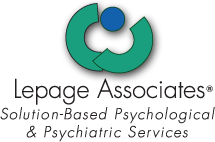Cognitive Behavioral Therapy, also known as CBT, is an evidence based treatment modality based on the idea that your thoughts influence the way you feel and behave. For example, when a negative or positive event occurs, your thoughts about it affect how you feel, which in turn impacts your behavior. Sometimes thoughts can be irrational and/or distorted. Treatment involves cognitive restructuring, which is identifying unreasonable thoughts and learning to replace them with positive, healthy ones. Homework is an integral part of CBT, which involves providing clients strategies to implement in the real world outside of therapy.
CBT is a short-term course of treatment, usually involving six to twenty weekly sessions. After gathering general background information, the therapist identifies specifically how and when your symptoms manifest, and in turn affect your life. For example, some people become anxious in social situations. They may worry others are judging them (distorted thinking), which will affect how they feel and impact their behavior. It may be difficult for them to remain in the present and respond to others because they are caught up in their own thoughts about what they believe the other person is thinking about them.
Another example of distorted thinking is a student walking across campus who sees a friend with an angry expression on their face. The student may irrationally worry they said or did something previously to their friend that made them angry, when it may simply be the friend is having a difficult day that has absolutely nothing to do with them. But because of the irrational thoughts, the student may feel bad or guilty and respond to the friend by saying something based on their feelings rather than just walking away and forgetting about it. Distorted thinking can also affect couples. For instance, if a spouse comes home from work and notices their partner looks unhappy, they may assume it is because of something they did and respond defensively rather than seek the facts of the situation.
In therapy, once irrational thought patterns are identified, then specific strategies are taught to stop and/or replace them. Strategies include challenging and replacing irrational thoughts with factual information, using Socratic questions (a series of questions named after Socrates) to reevaluate previous assumptions or perspectives, and de-catastrophizing cognitive distortions (not exaggerating or expecting the worst possible outcome). This is a sampling of CBT strategies that can be tailored to and tweaked for specific people and situations. Clients will also be taught relaxation and/or mindfulness techniques to calm their physiological responses to the anxiety (or depression, stress, etc.) they experience.
CBT is the gold standard for use with anxiety-based disorders. It is effective with generalized anxiety disorder (GAD), social anxiety, phobias, obsessive compulsive disorder (OCD), and post-traumatic stress disorder (PTSD). CBT is also used to treat depressive disorders such as major depressive disorder (MDD), persistent depressive disorder (PDD), and disruptive mood dysregulation disorder (DMDD). Other mental health issues CBT is used to treat include sleep, eating and substance abuse disorders.
It is important to note CBT is most effective when the client commits to implementing the strategies learned in real world situations. It is an active, not a passive, type of talk therapy. Practice will enable an individual to change their automatic ways of thinking and responding and replace them with healthier alternatives.
